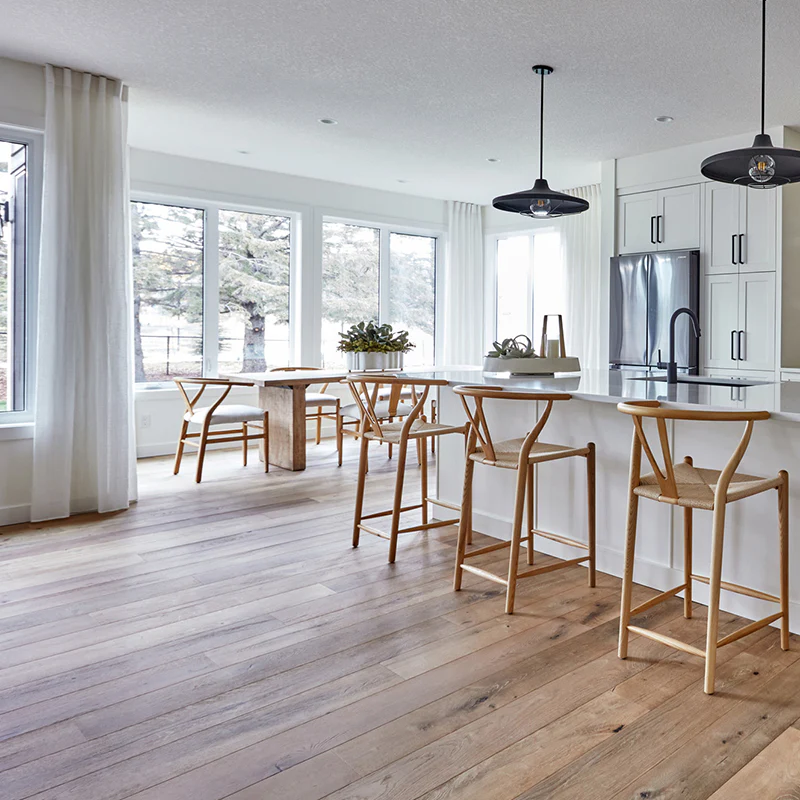
When shopping for hardwood flooring, it’s easy to get sticker shock. One plank might cost $4.99 per square foot, while another looks nearly identical but runs closer to $12. So what’s really driving that price difference?
Let’s break down what makes some hardwood flooring more expensive from how the wood is cut to what’s inside an engineered plank and even the subfloor beneath it.
Species and Sourcing
The species of wood is often the first major factor. Domestic hardwoods like oak, hickory, and maple are typically more affordable than exotic options such as Brazilian cherry, acacia, or teak.
Rarer species grow more slowly, require longer transport distances, and are often subject to import tariffs all of which raise the cost.
Even within a single species, grading matters. “Select” or “clear” grades have fewer knots and more uniform grain, while “rustic” or “character” grades come with visible knots, color variation, and mineral streaks usually at a lower price point.
Solid vs. Engineered Hardwood
Solid hardwood is milled from a single piece of wood. It can be sanded and refinished multiple times, making it ideal for longevity, but it’s more sensitive to humidity and temperature changes.
Engineered hardwood, on the other hand, is built in layers:
Top Layer (Veneer): The real hardwood surface you see.
Core Layers: Plywood, high-density fiberboard (HDF), or multi-ply constructions that stabilize the floor.
The core material makes a big difference in both price and performance.
HDF cores are cheaper and denser, but not as stable in moisture-prone environments.
Multi-ply cores made with cross-grain birch or poplar layers cost more but offer superior dimensional stability and longevity.
Premium engineered floors often have a thicker wear layer (around 3–6mm), allowing for refinishing, which adds to cost but increases lifespan.
Cut Types: How the Log is Sawn
The way the hardwood is cut from the log dramatically impacts both look and cost:
Plain-sawn: The most common and affordable method, showing a traditional cathedral grain.
Quarter-sawn: Cuts the log at a 60–90° angle, producing a straight, linear grain and enhanced stability.
Rift-sawn: A premium cut that produces the most consistent grain pattern and resists warping, often used in high-end oak floors.
Because rift and quarter-sawing waste more of the log, the yield is lower, and the cost goes up.
Finishes: From Factory Coats to Custom Stains
Finishing can easily double the cost of a floor.
Unfinished flooring requires sanding, staining, and sealing onsite, labor-intensive but customizable.
Prefinished hardwood is treated at the factory with multiple coats of UV-cured aluminum oxide or ceramic-infused finishes, creating an ultra-durable surface.
High-end finishes resist scratches, fading, and wear for decades, and often come with extended warranties.
Subfloor & Installation Requirements
Not every floor can go over every subfloor, and that affects total cost.
Solid hardwood generally needs to be nailed down over a plywood subfloor, which means it’s not ideal for concrete slabs or below-grade basements.
Engineered hardwood offers more flexibility it can be glued, floated, or stapled over concrete, radiant heat systems, or even existing floors, depending on the core.
If your subfloor isn’t level or has moisture issues, extra prep or a vapor barrier may be needed adding to labor and material costs.
Brand, Warranty, and Origin
Like most products, brand reputation and manufacturing standards matter. Floors produced in the U.S. or Europe often undergo stricter quality controls and offer longer warranties than cheaper imports. These factors can justify a higher price point through better stability, safety, and peace of mind.
In Summary
When it comes to hardwood flooring, you get what you pay for isn’t just a saying, it’s reality.
The type of wood, the way it’s cut, the quality of its core materials, the finish applied, and the installation method all combine to determine cost, performance, and longevity.
If you’re investing in hardwood floors, consider not just the upfront price but how long you plan to stay in your home, the traffic in your space, and the look you want to achieve.
Hardwood will balance beauty, durability, and add value for years to come!
